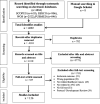A scoping review of digital technologies in antenatal care: recent progress and applications of digital technologies
- PMID: 39948493
- PMCID: PMC11827299
- DOI: 10.1186/s12884-025-07209-8
A scoping review of digital technologies in antenatal care: recent progress and applications of digital technologies
Abstract
Introduction: Digital health technologies have vastly improved monitoring, diagnosis, and care during pregnancy. As expectant mothers increasingly engage with social media, online platforms, and mobile applications, these innovations present valuable opportunities to enhance the quality of maternal healthcare services.
Objective: This review aims to assess the applicability, outcomes, and recent advancement of digital health modalities in antenatal care.
Method: We conducted a scoping review by searching four electronic databases (Scopus, Web of Science, PubMed, EBSCOhost), performing manual searches of Google Scholar, and examining the references of relevant studies. Eligible studies included original research published in English between 2010 and 2024 involving the use of digital health technologies for antenatal care, complying with the Preferred Reporting Items for Systematic Reviews and Meta-Analyses extension for scoping review guidelines.
Results: One hundred twenty-six eligible articles were identified, with the majority (61.11%) conducted in high-income countries, including the United States, United Kingdom, and Australia. Digital health studies have increased over time, driven by telehealth adoption in affluent nations. Interventions predominantly focused on patient-provider consultations, remote monitoring, and health education, complementing in-person visits or as a substitute when necessary. High levels of acceptance and satisfaction were reported among users. These interventions primarily targeted general maternal care (28.57%), gestational diabetes mellitus (15.07%), and mental health (13.49%) while also addressing gestational weight management, hypertensive disorders, high-risk pregnancies and maternal education. The findings demonstrated positive outcomes in managing clinical conditions, enhancing knowledge, promoting birth preparedness, and improving antenatal care access and utilisation. Additionally, the findings revealed the cost-effectiveness of these approaches in alleviating financial burdens for patients and healthcare systems.
Conclusion: Digital health is emerging as a pivotal tool in maternal and child care, fostering positive outcomes and high acceptance among patients and healthcare providers. Its integration into antenatal care ensures the maintenance of standard care quality, with no adverse effects reported despite limited discussions on safety and privacy concerns. As these technologies continue to evolve, they are set to redefine antenatal care by offering more accessible, efficient, and patient-centred solutions, ultimately shaping the future of maternal healthcare delivery.
Keywords: Consultation; Digital health; Gestational; Mobile health; Prenatal care; Remote monitoring; Telehealth; Telemedicine.
© 2025. The Author(s).
Conflict of interest statement
Declarations. Ethics approval and consent to participate: Not applicable. Consent for publication: Not applicable. Competing interests: The authors declare no competing interests.
Figures
Similar articles
-
Beyond the black stump: rapid reviews of health research issues affecting regional, rural and remote Australia.Med J Aust. 2020 Dec;213 Suppl 11:S3-S32.e1. doi: 10.5694/mja2.50881. Med J Aust. 2020. PMID: 33314144
-
A scoping review of digital health technologies in multimorbidity management: mechanisms, outcomes, challenges, and strategies.BMC Health Serv Res. 2025 Mar 15;25(1):382. doi: 10.1186/s12913-025-12548-5. BMC Health Serv Res. 2025. PMID: 40089752 Free PMC article.
-
Cultural and Digital Health Literacy Appropriateness of App- and Web-Based Systems Designed for Pregnant Women With Gestational Diabetes Mellitus: Scoping Review.J Med Internet Res. 2022 Oct 14;24(10):e37844. doi: 10.2196/37844. J Med Internet Res. 2022. PMID: 36240008 Free PMC article.
-
Mobile technology in health (mHealth) and antenatal care-Searching for apps and available solutions: A systematic review.Int J Med Inform. 2019 Jul;127:1-8. doi: 10.1016/j.ijmedinf.2019.04.008. Epub 2019 Apr 12. Int J Med Inform. 2019. PMID: 31128820
-
Lessons from digital technology-enabled health interventions implemented during the coronavirus pandemic to improve maternal and birth outcomes: a global scoping review.BMC Pregnancy Childbirth. 2023 Mar 20;23(1):195. doi: 10.1186/s12884-023-05454-3. BMC Pregnancy Childbirth. 2023. PMID: 36941565 Free PMC article.
Cited by
-
The effectiveness of nurse-led antenatal education on maternal self-efficacy: an evidence-based approach.BMC Nurs. 2025 Jul 10;24(1):895. doi: 10.1186/s12912-025-03471-5. BMC Nurs. 2025. PMID: 40640815 Free PMC article.
References
-
- Sartika D, Razak A, Arifin MA, Kardi M, Jafar N. Evaluation of the antenatal care service program at the Tojo Una-Una district health office. Pharmacogn J. 2024;16(3):615–23. 10.5530/pj.2024.16.97.
-
- Boureka E, Tsakiridis I, Kostakis N, Giouleka S, Mamopoulos A, Kalogiannidis I, Dagklis T. Antenatal Care: A Comparative Review of Guidelines. Obstetr Gynecolog Surv. 2024;79(5):290–303. - PubMed
-
- Raymond VG, Ndalla MM, Tibenderana JR. Antenatal care access in Tanzania: progress, challenges, and recommendations for a healthier maternal and child well-being. IJS Global Health. 2023;6(6): e0370.
-
- World Health Organization. WHO Guideline: Recommendations On Digital Interventions For Health System Strengthening: Web Supplement 2: Summary of Findings and GRADE Tables (No. WHO/RHR/19.7). Switzerland (GVA): 2023 WHO; 2019. Available from: https://apps.who.int/iris/handle/10665/324998. Updated 2021. - PubMed
Publication types
MeSH terms
LinkOut - more resources
Full Text Sources
Medical
Research Materials





